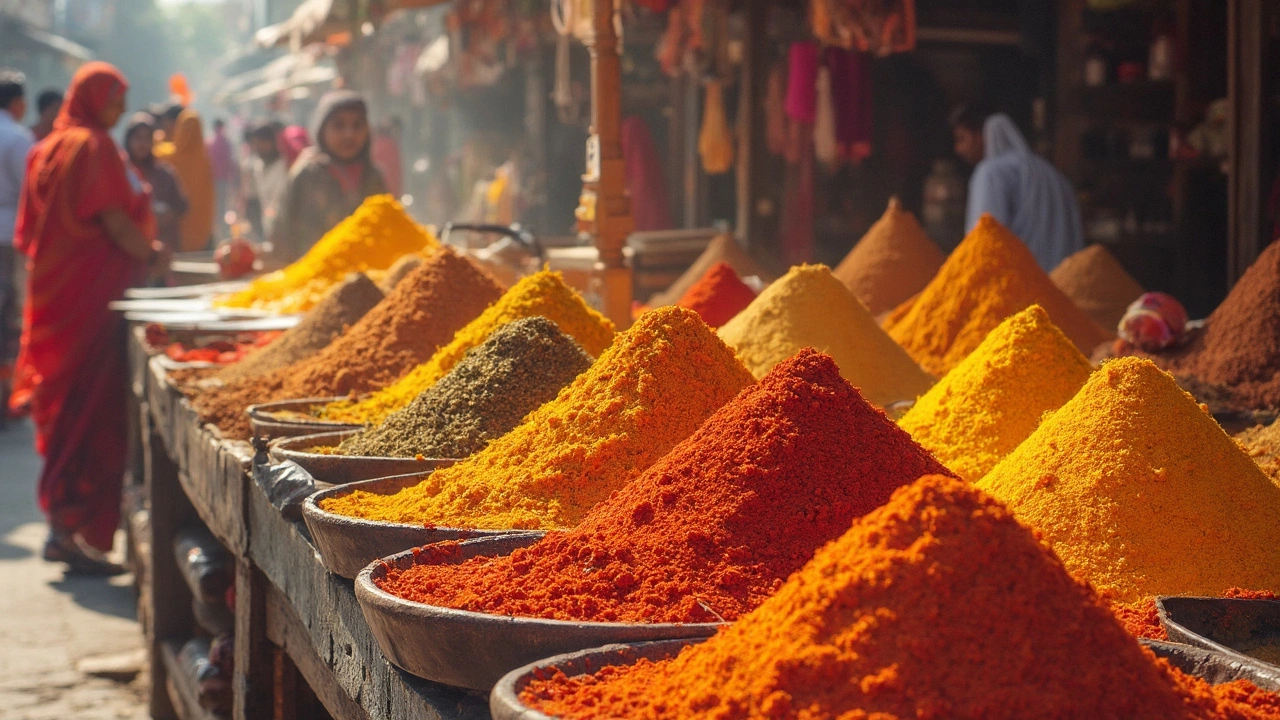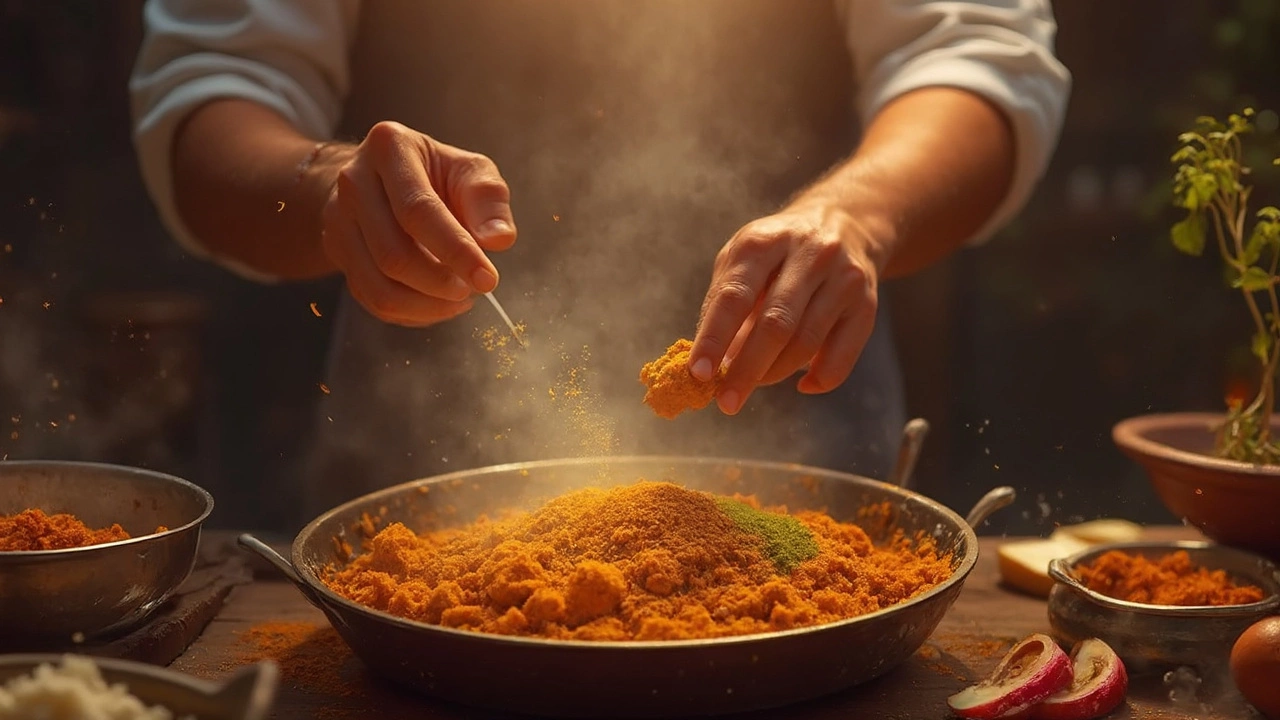Unlocking Flavor: The Four Main Spices in Curry

Alright, picture this: you're in the kitchen, ready to whip up your favorite chicken curry. But to truly nail that fragrant, savory taste, you need to know about the four spices at its core. These seasonings aren't just components; they're the soul of a curry.
First up, cumin's got your back with an earthy depth that lingers in every bite. It's been around for ages, pretty much the cousin of the spice world, bringing warmth in heaps. Then we've got turmeric; it's not just about turning your curry a glorious gold. This little gem offers a subtle, bitter edge and packs a punch of health benefits too.
Now, let's not forget coriander – this one's zesty and slightly citrusy, adding layers of flavor and a hint of sweetness. And finally, there's the red chili powder, adjusting the heat to your personal preference and tying all those flavors together with a nice kick.
These spices don’t stand alone; they work together in harmony to bring out that signature curry taste. Master these, and you've unlocked the secret to an unforgettable curry experience.
- Diving into Curry's Essential Four
- The Role of Cumin
- Turmeric: More than Just Color
- Coriander's Zesty Charm
- Kick of Red Chili Powder
- Tips for Perfect Spice Balance
Diving into Curry's Essential Four
When it comes to crafting a memorable chicken curry, knowing the backbone of the dish is key. These aren't just random ingredients tossed into a pot; each spice has a purpose, and together, they create magic.
Cumin: The Earthy Backbone
Cumin seeds may be small, but they pack an earthy flavor that forms the foundation of any good curry. It's like the bass in your favorite tune—sets the mood right. Did you know cumin has been used in cooking since ancient Egypt? Yeah, it's definitely earned its place in the spotlight!
Turmeric: Nature's Golden Spice
Then there's turmeric. This one's a multitasker, adding both color and a gentle, slightly bitter undertone. It's like the yellow highlighter of spices—can't miss it. Plus, it's lauded for its anti-inflammatory properties. Some people even sip on turmeric-infused drinks for health benefits.
Coriander: Zesty and Citrusy
Coriander introduces a bright, lemony flavor to the mix, balancing the deep, warm notes of cumin and turmeric. It's often used ground, but the seeds themselves pack a punch. Fun fact: coriander seeds were found in Tutankhamun's tomb because hey, even pharaohs loved a good curry-like dish!
Red Chili Powder: Adding Spice to Your Life
And let's talk about red chili powder. This is where you decide how much heat you can handle. It's not just about pain—it enhances the other flavors, making them dance on your taste buds. Pro tip: start small, then build up the heat as you get more comfortable.
Now, whether you're cooking for the family or impressing some friends, these four spices will guide you to curry greatness. The best part? You can tweak and adjust till you find that perfect blend that sings in your kitchen.
The Role of Cumin
Let's dive into the world of cumin, a true cornerstone in curry spices. This little seed packs a big punch with its distinctive earthy, warm flavor that can make your chicken curry unforgettable. Originating from the Mediterranean and the Middle East, cumin has been celebrated for ages, not only in cooking but as a part of traditional medicine.
Why does cumin matter so much? For starters, it adds a rich depth to your dishes, often described as slightly nutty, with a hint of bitterness that blends well with other curry ingredients. Plus, it's loaded with health benefits, from aiding digestion to being rich in antioxidants.
Health Perks of Cumin
Emailing cumin into your meals isn't just about taste. It's known for its potential to help with digestion and boost immunity. In fact, a sprinkle of cumin powder can aid in reducing bloating and improve your gut health.
Pro Tips for Using Cumin
- Always keep a stock of both whole seeds and ground cumin. Toast the seeds lightly before grinding them for an extra burst of aroma.
- For a heartier flavor, consider blooming cumin seeds in oil before adding them to your curry.
- Balance is key. Too much cumin can overpower other flavors, so start by adding a teaspoon, taste, and adjust as needed.
Main curry spices like cumin play a vital role, not just flavor-wise but in adding texture and aroma. The nutty notes of cumin seeds can elevate your recipe, making the dining experience more enjoyable. Remember, the secret to an aromatic chicken curry lies in understanding and using these foundational spices correctly.
Turmeric: More than Just Color
So, you've heard that turmeric turns your curry a vibrant yellow, right? But it's so much more than a splash of color. This golden spice is like a jack-of-all-trades, pulling double duty with both flavor and health benefits.
First off, don't underestimate its earthy, slightly bitter taste that balances out the spices ensemble in any chicken curry. It acts like the grounding force amid a whirlwind of flavors, ensuring each bite is smooth and well-rounded.
Health Benefits: More than Meets the Eye
Turmeric houses curcumin, the magical compound that's got everyone in a tizzy. It's been flaunted for its anti-inflammatory properties, and there are chats in medical circles about its potential to fight off conditions like heart disease and arthritis. Talk about hidden talents!
Cooking with Turmeric
Here’s a tip: mixing turmeric with black pepper can enhance curcumin absorption by 2000%. Why? The piperine in black pepper boosts curcumin's bioavailability. So, when you're cooking up that chicken curry, a pinch of pepper isn't just for taste—it's a turbocharger.
Choosing and Storing Turmeric
Ever wonder why your curry spices don't hit the same at times? Always go for fresh, bright turmeric powder. Avoid the faded stuff—over time, it loses its flavor oomph. Store it in a cool, dark place to keep that punchy flavor locked in.
In short, next time you're cooking with turmeric, appreciate it for more than just its sheen. It's a small powerhouse, blending flavor with perk-me-up health benefits.

Coriander's Zesty Charm
Ever wonder what gives your chicken curry that punchy, fresh note? It's none other than coriander! This spice is like the zesty life of the party in your curry mix – it adds a citrusy zing that cuts through the rich flavors.
Coriander's origins go back to ancient Egypt where the seeds were cherished for both their flavor and medicinal properties. Today, it's still a key player in kitchens worldwide. When you're cooking curry, you're likely using the seeds, which are ground into a fine powder for that sweet, aromatic touch. Ever bitten into a seed by mistake? Yep, that's a mini explosion of flavor right there!
How to Use Coriander in Curry
For the best balance, toss in the coriander early in your cooking process. This way, the spice has time to bloom, blending its zesty charm seamlessly throughout the dish. It won't overpower other flavors but will enhance them nicely. Got whole seeds? Toast them lightly in a dry pan to intensify the aroma before grinding.
Not just a flavor hero, coriander might also do wonders for your health. Studies suggest it can aid digestion and reduce inflammation. That's right, it's not just delicious but potentially beneficial for your wellbeing too.
| Benefit | Effect |
|---|---|
| Digestive Aid | May improve digestion |
| Anti-inflammatory | Could reduce inflammation |
So, next time you're jazzing up your curry, remember coriander's zesty charm. Embrace it, let it dance with the other spices, and enjoy the vibrant taste it brings to your beloved chicken curry.
Kick of Red Chili Powder
So, let's talk about red chili powder. It's the spice that most vividly defines the heat in your curry. Don't worry, it doesn't just burn your tongue off (unless you want it to). What it really does is add an unmistakable heat level that makes curry one of the most exciting dishes in the whole world.
Red chili powder comes from ground-up red chilies, and boy, does it pack flavor! It's not just about dialing the heat up and down. Did you know that the type of chili you use and how you use it can significantly shift the taste of your entire dish?
Types of Red Chili Powder
There's a variety of red chili powders out there, each bringing something a little different to the plate. You've got the classic cayenne pepper, which is super popular for a reason. Then there's Kashmiri chili powder, known for bringing rich color without too much heat—ideal if you're serving folks who aren’t chili-heads. Can't decide? Try experimenting with both to find your perfect balance.
How Much is Too Much?
When it comes to chicken curry, how much red chili powder is just right? A general rule of thumb is to start small. You can always add more, but once it's in there, you're stuck with it. For a dish serving around four people, a teaspoon of chili powder usually hits that sweet spot.
If you're interested in precise measurements to walk the fine line between flavor and fire, consider referencing this handy table:
| Spiciness Level | Amount of Red Chili Powder |
|---|---|
| Mild | 1/2 teaspoon |
| Medium | 1 teaspoon |
| Hot | 1-1/2 teaspoons or more |
Remember, integrating curry spices like red chili is as much about personal taste as it is about following the recipe. Don't be afraid to make a mess and have fun with it!
Tips for Perfect Spice Balance
Getting the spice balance just right in a chicken curry can feel like tackling a mini science project, but trust me, it's easier than you think. Let’s break it down so you can master the art of balancing those four main curry spices.
Start Small, Adjust As You Go
It’s always safer to start with less. You can add more seasoning, but removing excess is tricky. Begin with a half teaspoon of each key spice and taste as you go. Your taste buds are your best guide!
Pairing Spices Appropriately
Cumin and coriander love each other. They’re like the best duo since peanut butter met jelly. Cumin provides that rich, nutty layer while coriander adds a fresh, lemony note. Balance them equally to ensure neither gets lost in the mix.
Mind the Heat
When it comes to red chili powder, everyone’s heat tolerance is different. A general rule is one teaspoon for a mild kick, but feel free to dial it up or down. Too spicy? A spoonful of yogurt can help mellow it out.
Don’t Forget the Turmeric
Though subtle, the turmeric in your curry isn’t just a pretty face. Aim for about half the amount of turmeric to cumin for that nice earthy foundation without overpowering.
| Spice | Amount for 4 Servings |
|---|---|
| Cumin | 1 tsp |
| Turmeric | 1/2 tsp |
| Coriander | 1 tsp |
| Red Chili Powder | up to 1 tsp (to taste) |
Play around with these amounts to suit your tastes, and soon you’ll find your perfect balance. Remember, cooking is an art, not a science, so feel free to experiment. That’s where the magic happens!